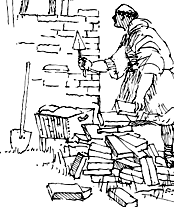Meet the Middle Ages
BackHandicraft

There was a great need for different craftsmen in the medieval towns. Bricklayers built houses, tin-smiths made jugs and jars, smiths made knifes and candle-holders, linen-weavers wove linen, potters made pots and so on. The craftsmen sold their goods from stalls on the ground floor of their workshops.
During the Middle Ages, anyone who was a citizen, was allowed to set up his own workshop. From mid-15th century and onwards, craftsmen in Scandinavia started organising themselves in craft-guilds, one for each profession. On the continent, this had taken place as early as in the 13th and 14th centuries.
To become a member of a guild, you had to have your training within a certain craft. Then you had to prove your skills, first by making a qualifying piece of work, and finally by an examination for the master. The guild would only accept a new member if there was a need for a new craftsman within the craft in question. The guilds increased the control over the craftsmen, but it was on the old craftsmen’s terms.
Unlike the merchants, craftsmen did not have the right to buy and sell as they pleased. They were only allowed to sell their own products and to buy what they needed for their households or workshops.